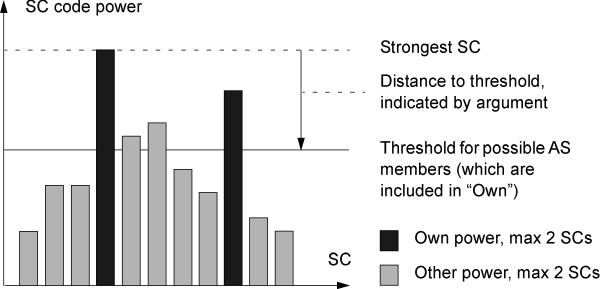60.2.8 Presentation: "Poss No Of AS Members" and "Other/Own" Information Elements
These information elements are diagnostic of the CPICH pilot pollution situation.1
Poss No Of AS Members:
The active set (AS) is defined as the set of scrambling codes (SCs) associated with channels that are assigned to a particular subscriber unit. Here an SC is regarded as a possible active set member if it is sufficiently strong compared to the strongest SC. The relative code power threshold is determined by the argument within square brackets [ ]. Note that one cannot know for sure (on the basis of the scan data alone) whether the possible members actually do belong to the active set.
Example: If the argument is 3 (default value), all SCs with a code power not more than 3 dB below that of the strongest SC will be counted. In the above figure, there are three such SCs, so the active set is judged to have a total of four possible members.
Other/Own ... :
These are estimated ratios between polluting signal power and desired signal power, based on the power threshold described above (again given as argument to each information element) and on different assumptions about the number of possible active set members. The four "Other/Own" elements represent the assumptions that there is desired signal power on 1, 2, 3, and 4 SCs respectively.
For "Max N SCs", "Own" is the sum of the code powers of the N strongest possible active set members, if the number of possible members is at least N; otherwise it is simply the sum of the code powers of all possible active set members. "Other" is the sum of the code powers of all remaining SCs.
In the example below, there are three other SCs reaching above the threshold which is set relative to the strongest SC. However, for "Max 2 SCs", only the strongest of the three is included in "Own".

The "Other/Own" ratios are of course calculated from absolute code power values (i.e. Ec values in mW).
|
Note: The arguments should be kept the same for all five information elements. It is of course possible to set each argument to any of the permissible values, but with different arguments for different elements you cannot really draw any useful conclusions. |
